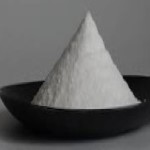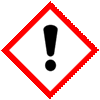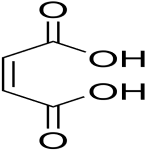CAS Number 110-16-7, Maleic Acid USP BP Ph Eur Grade Manufacturers Exporters







CAS Number 110-16-7, Maleic Acid Manufacturer Exporter
For Properties Specifications of Maleic Acid Click Properties, Specifications of Maleic Acid Manufacturer.
For Uses of Maleic Acid Click Uses of Maleic Acid Manufacturer.
For For SDS MSDS Sheet of Maleic Acid Click SDS Safety Data Sheet MSDS Sheet of Maleic Acid Manufacturer.
The Properties and Specifications of Maleic Acid:
Maleic Acid USP Grade Specifications
Maleic Acid
C4H4O4 116.07
(Z)-Butenedioic acid
Cis-Butenedioic acid CAS 110-16-7
Maleic Acid contains not less than 99.0 percent and not more than 101.0 percent of C4H4O4, calculated on the anhydrous basis.
Identification:
A: Dissolve about 500 mg of Maleic Acid in 10 mL of water: the pH of the solution is less than 2.
B: To pass chromatography test
C: Dissolve about 35 mg of resorcinol in 10 mL of sulfuric acid (Resorcinol solution). Dissolve about 100 mg of Maleic Acid in 10 mL of water (Test solution). To 0.3 mL of the Test solution add 3 mL of the Resorcinol solution, and heat in a water bath for 15 minutes: no color develops. To 3 mL of the Test solution add 1 mL of bromine TS, heat in a water bath for 15 minutes to remove the bromine, then heat to boiling, and cool. To 0.2 mL of this solution, add 3 mL of the Resorcinol solution, and heat in a water bath for 15 minutes: a violet-pink color develops.
Color and clarity of solution:
Dilute hydrochloric acid solution: Mix 27.5 mL of hydrochloric acid with sufficient water to make 1000 mL.
Reference solution: Mix 2.4 mL of ferric chloride CS and 0.6 mL of cobaltous chloride CS with Dilute hydrochloric acid solution to make 10 mL. Dilute 5 mL of this solution with Dilute hydrochloric acid solution to make 100 mL.
Test solution: Dissolve about 5 g of Maleic Acid in 50 mL of water.
Procedure: Place the Reference solution and the Test solution in matched color-comparison tubes, and compare the solutions by viewing them downward against a white surface : the Test solution is clear and not more intensely colored than the Reference solution.
Water: not more than 2.0% is found.
Residue on ignition: not more than 0.1%, determined on a 1.0-g portion.
Heavy metals: not more than 10 µg per g.
Limit of fumaric acid: To pass the test
Limit of iron: not more than 5 µg per g.
Maleic Acid BP Ph Eur Grade Specifications
C4H4O4 -- 116.1 -- CAS 110-16-7
DEFINITION
Maleic acid contains not less than 99.0 per cent and not more than the equivalent of 101.0 per cent of (Z)-butenedioic acid, calculated with reference to the anhydrous substance.
CHARACTERS
A white, crystalline powder, freely soluble in water and in alcohol.
IDENTIFICATION
A. Dilute 5 ml of solution S (see Tests) to 10 ml with water. The pH of the dilution is less than 2.
B. Examine the chromatograms obtained in the test for fumaric acid. The principal spot in the chromatogram obtained with test solution (b) is similar in position and size to the principal spot in the chromatogram obtained with reference solution (a).
C. Dissolve 0.1 g in 10 ml of water (solution a). To 0.3 ml of solution (a) add a solution of 10 mg of resorcinol in 3 ml of sulphuric acid. Heat on a water-bath for 15 min; no colour develops. To 3 ml of solution (a) add 1 ml of bromine water. Heat on a water-bath to remove the bromine (15 min), heat to boiling and cool. To 0.2 ml of this solution add a solution of 10 mg of resorcinol in 3 ml of sulphuric acid. Heat on a water-bath for 15 min. A violet-pink colour develops.
TESTS
Solution S: Dissolve 5.0 g in water R and dilute to 50 ml with the same solvent.
Appearance of solution: Solution S is clear and not more intensely coloured than reference solution.
Fumaric acid: To pass the test
Iron: To 10 ml of solution S add 2 ml of dilute hydrochloric acid and 0.05 ml of bromine water. After 5 min, remove the excess of bromine by passing a current of air and add 3 ml of potassium thiocyanate solution. Shake. Prepare a standard at the same time and in the same manner, using a mixture of 5 ml of iron standard solution (1 ppm Fe) R, 1 ml of dilute hydrochloric acid, 6 ml of water and 0.05 ml of bromine water. Allow both solutions to stand for 5 min. Any red colour in the test solution is not more intense than that in the standard (5 ppm).
Heavy metals: 1.0 g complies with limit test D for heavy metals (10 ppm).
Water: Not more than 2.0 per cent, determined on 1.00 g by the semi-micro determination of water.
Sulphated ash: Not more than 0.1 per cent, determined on 1.0 g.
The Uses of Maleic Acid:
Maleic acid may be used to form acid addition salts with drugs to make them more stable. It is used for manufacturing of artificial resins, dyeing and finishing wool etc.
The MSDS-SDS Hazard Statement of Maleic Acid:
Maleic Acid SDS, Safety Data Sheet
MSDS Sheet, Material Safety Data Sheet 15-Jan-23
1. Product Identification
Product Name & Other Names: Maleic Acid or (Z)-Butenedioic acid or cis-butenedioic acid or maleinic acid or toxilic acid.
CAS No.: 110-16-7
EINECS EC Number: 203-742-5
Molecular Weight: 116.08
Chemical Formula: HOCOCH:CHCOOH
Relevant uses and uses advised against (if any): Industrial Manufacturing.
2. Hazards Identification
GHS, Globally Harmonized System Classification in accordance with 29 CFR 1910
Classification according to Regulation (EC) No 1272/2008
Acute toxicity, Oral (Category 4), H302
Skin irritation (Category 2), H315
Eye irritation (Category 2), H319
Skin sensitization (Category 1), H317
Specific target organ toxicity - single exposure (Category 3), Respiratory system, H335
Labeling according to GHS & Regulation (EC) No 1272/2008
GHS Label Elements  Irritant |
Signal Words: Warning
Hazard statements:
H302: Harmful if swallowed.
H315: Causes skin irritation.
H317: May cause an allergic skin reaction.
H319: Causes serious eye irritation.
H335: May cause respiratory irritation.
Precautionary statements:
P261: Avoid breathing dust/fume/gas/mist/vapors/spray.
P264: Wash … thoroughly after handling.
P270: Do not eat, drink or smoke when using this product.
P272: Contaminated work clothing should not be allowed out of the workplace.
P280: Wear protective gloves/protective clothing/eye protection/face protection.
P330: Rinse mouth.
P362: Take off contaminated clothing and wash before reuse.
P501: Dispose of contents/container to authorized agents only.
P301+312: IF SWALLOWED: Call a POISON CENTER or doctor/physician if you feel unwell.
P302+352: IF ON SKIN: Wash with soap and water.
P333+313: If skin irritation or a rash occurs: Get medical advice/attention.
P305+351+338: IF IN EYES: Rinse cautiously with water for several minutes. Remove contact lenses if present and easy to do – continue rinsing.
P337+313: If eye irritation persists get medical advice/attention.
3. Composition/Information on Ingredients
Product Name & Other Names: Maleic Acid or (Z)-Butenedioic acid or cis-butenedioic acid or maleinic acid or toxilic acid.
CAS No.: 110-16-7
EINECS EC Number: 203-742-5
4. First Aid Measures
Always seek medical attention after first aid measures are provided.
Inhalation: If Maleic Acid is inhaled, remove to fresh air. If not breathing, give artificial respiration. If breathing is difficult, give oxygen and get medical attention immediately.
Ingestion: Induce vomiting immediately as directed by medical personnel. Never give anything by mouth to an unconscious person. Get medical attention.
Skin Contact: Immediately flush skin with plenty of water for at least 15 minutes while removing contaminated clothing and shoes. Get medical attention. Wash clothing and shoes before reuse.
Eye Contact: Immediately flush eyes with plenty of water for at least 15 minutes, lifting lower and upper eyelids occasionally. Get medical attention immediately.
5. Fire Fighting Measures
Fire: As with most organic solids, fire is possible at elevated temperatures or by contact with an ignition source.
Explosion: Fine dust dispersed in air in sufficient concentrations, and in the presence of an ignition source is a potential dust explosion hazard.
Special hazards arising from the substance or mixture: Fumes and carbon oxides
Fire Extinguishing Media: Water spray, dry chemical, alcohol foam, or carbon dioxide.
Special Information: In the event of a fire, wear full protective clothing and NIOSH-approved self-contained breathing apparatus with full face piece operated in the pressure demand or other positive pressure mode. At high temperatures under fire conditions, it may produce toxic or irritating fumes. Fire-extinguishing work is done from the windward and the suitable fire-extinguishing method according to the surrounding situation is used.
6. Accidental Release Measures
Personal precautions, protective equipment, and emergency procedures: Avoid breathing dust/fumes/gas/mist/vapors/spray. Ensure adequate ventilation. Use individual protective equipment (waterproof boots, suitable protective clothing, safety glasses, etc.). Do not approach facing the wind.
Environmental precautions: Do not let the product enter drains, soil or water sources.
Methods and materials used for containment Cleanup procedures and Storage: Contain spilled material. Irritating solid. Harmful solid. Cover with an inert, non-combustible absorbent material, (e.g. sand, earth, diatomaceous earth, vermiculite). Vacuum or sweep-up and remove to an approved disposal container. Use water spray to reduce vapors.
7. Handling and Storage
Precautions for safe handling: Apply according to good manufacturing and industrial hygiene practices. Ensure proper ventilation. Wash thoroughly after handling. Do not drink, eat, or smoke while handling. Avoid contact with skin, eyes, and clothing. Minimize dust generation. Avoid breathing dust/fumes/gas/mist/vapors/spray. Keep container tightly closed. Avoid ingestion and inhalation. Use individual protective equipment (waterproof boots, suitable protective clothing, safety glasses, etc.).
Conditions for safe storage, including any incompatibilities: Store in cool, dry, and ventilated area away from heat sources and protected from sunlight in tightly closed original container. Keep air contact to a minimum. Do not leave the material container open. Store protected from heat, sparks, and ignition sources. Avoid contact with skin and eyes. Avoid inhalation of dust/mist/vapor. Do not store with incompatible materials like strong oxidizers.
8. Exposure Controls/Personal Protection
Airborne Exposure Limits: None established.
Ventilation System: A system of local and/or general exhaust is recommended to keep employee exposures as low as possible.
Personal Respirators (NIOSH Approved): For conditions of use where exposure to dust or mist is apparent and engineering controls are not feasible, a particulate respirator (NIOSH type N95 or better filters) may be worn.
Skin Protection: Wear impervious protective clothing, including boots, gloves, lab coat, apron or coveralls, as appropriate, to prevent skin contact.
Eye Protection: Use chemical safety goggles and/or full face shield where dusting or splashing of solutions is possible. Maintain eye wash fountain and quick-drench facilities in work area.
Other Control Measures: Maintain good housekeeping in work area. Handle in accordance with good industrial hygiene and safety practice.
9. Physical and Chemical Properties
Appearance: Maleic Acid is white crystals.
Odor: Faint acidulous odor.
Odor threshold: Not available.
pH: < 7 Acidic.
Relative density: 1.590 @ 20C.
Boiling Point: 135C (275F) Decomposes.
Melting Point: 130 - 139C (266 - 282F)
Flash point: Not available.
Auto-ignition temperature: Not available.
Decomposition temperature: Not available.
Upper/lower flammability or explosive limits: Not available.
Vapor pressure: Not available.
Vapor density: Not available.
Evaporation rate: Not available.
Flammability (solid, gas): Not available.
Partition coefficient: n-octanol/water: Not available.
Solubility: Soluble in water.
Viscosity: Not available.
10. Stability and Reactivity
Stability: Stable under ordinary conditions of use and storage.
Hazardous Decomposition Products: Carbon dioxide and carbon monoxide may form when heated to decomposition.
Hazardous Polymerization: Will not occur.
Incompatibilities: Strong oxidizers.
Conditions to Avoid: Heat, dusting and incompatibles.
11. Toxicological Information
Oral rat LD50: 708 mg/Kg
Skin rabbit LD50: 1560 mg/Kg Investigated as a mutagen.
Inhalation - Rat LC50: 1 h - > 720 mg/m3
Dermal - Rat LD50: > 5.000 mg/kg
Carcinogenicity: No component of this product present at levels greater than or equal to 0.1% is identified as probable or confirmed human carcinogen by IARC, ACGIH, OSHA and NTP.
Mutagenic Effects: Not available.
Developmental Toxicity: Not available.
Reproductive Effects: No information available.
12. Ecological Information
Environmental Fate: When released into the soil, Maleic Acid is expected to leach into groundwater. When released into the soil, this material is expected to readily biodegrade. When released into water, this material is expected to readily biodegrade. This material is not expected to significantly bio accumulate.
PBT and vPvB assessment: This substance/mixture contains no components considered to be either persistent, bioaccumulative and toxic (PBT), or very persistent and very bioaccumulative (vPvB) at levels of 0.1% or higher.
Toxicity to fish: LC50 - Oncorhynchus mykiss (rainbow trout) - 75 mg/l - 96 h
Toxicity to daphnia and other aquatic invertebrates: EC50 - Daphnia magna (Water flea) - 42,81 mg/l - 48 h.
13. Disposal Considerations
Whatever cannot be saved for recovery or recycling should be managed in an appropriate and approved waste disposal facility.
14. Transport Information
DOT USA, TDG Canada & ADR/RID Europe: Not controlled.
IMDG/IMO & IATA/ICAO: Not controlled.
15. Regulatory Information
USA:
SARA 311/312: See section 2.
16. Other Information
DISCLAIMER: The information and recommendations set forth herein are presented in good faith and believed correct as of the date hereof. It is compiled from various sources and it is not necessarily all inclusive nor fully adequate in every circumstance. In addition, these suggestions should not be confused with nor followed in violation of applicable laws, regulations, rules or insurance requirements applicable. This MSDS sheet is intended only as a guide to the appropriate precautionary handling of the material by a properly trained person using this product. Individuals receiving the information must exercise their independent judgment in determining its appropriateness for a particular purpose.
Anmol Chemicals & Pharmaceuticals Pvt. Ltd. is an off-shoot of Anmol Chemicals Taloja. It is located in MIDC Taloja and it is manufacturing pharmaceutical grades of API, Excepients, Food grade and Reagent grade chemicals. Anmol Chemicals & Pharmaceuticals Pvt. Ltd. is a several decades old group of companies, engaged in manufacturing, supplying, distributing, wholesale supplies for actual users, retail or small pack supplies for research and development chemicals, fine and speciality chemicals, pharmaceutical excipients, mineral fortifiers in chemically pure, Analytical reagent grade, IP BP USP Ph Eur EP JP and other pharmaceutical grade monograph including FCC Food grade chemicals and Nutraceuticals, Mineral Fortifiers at best prices.

Maleic Acid Structure
CAS Number 110-16-7, Maleic Acid Manufacturer Exporter
ANMOL CHEMICALS & PHARMACEUTICALS Pvt. Ltd.
India, USA, Europe, UAE
TELEPHONE: +912223770100
Navi Mumbai, INDIA
e-mail: info(At the rate i.e. @)anmol.org
Copyright. 16-nov-24
We manufacture:

